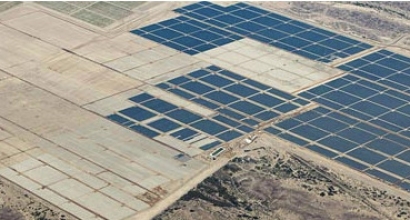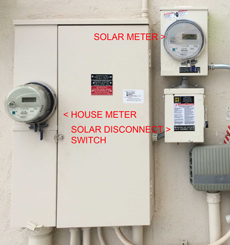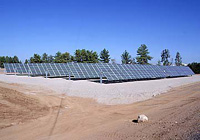


Updated December 2016
Electric utilities in Arizona are involved in solar energy in many ways. Utilities own or contract to purchase energy from large solar installations, both photovoltaic (PV) and thermal and distribute this energy to their customers. The utilities are also involved with their customers when customer utility interactive photovoltaic systems are connected to the utility grid in order to safely operate their systems and account to the energy transfers. Utilities call these smaller systems Distributed Generation (DG). Some utilities have rebate programs or other incentives to encourage solar hot water systems because these systems reduce the peak demands placed on the utilities.
The economies of scale favor large utility-scale solar systems such as illustrated on the left above, these systems can produce energy for about 60% of the cost of rooftop systems, but the energy must be transported to the areas where it is needed, requiring transmission lines, transformers, and such. About 10% of the energy is lost due to these transmission losses.
The utilities have to manage all the various electrical generation sources to balance the supply of energy with the customer use of energy, while keeping the voltage and frequency of the power within accepted limits. Since both solar generation and customer needs vary, this has become more difficult as the percentage of solar generated energy is increasing. Some of the generation resources, such as nuclear power plants, need to operate at constant power levels, while other sources such as natural gas turbines are designed to be variable. Photovoltaic power systems can be shut off without damage if necessary to help keep energy balanced within the utility system.
When a connected PV system, residence, business, school, etc., is generating more energy than can be used locally, the extra energy is fed back into the utility grid where it is used by other utility customers. The amount of solar generated energy thus fed back is metered by the utility.
The utilities account for this energy several methods. Most popular for the customers is Net Metering wherein the utility acts like a free battery, allowing a customer to later use an equivalent amount of energy for free. Another option is Net Billing wherein the utility basically purchases all the excess energy at a wholesale rate and sells all energy purchased by the customer at retail rates. The rates are set/approved by the Arizona Corporation Commission (ACC) (SRP is an exception since it is not an investor owned utility). Generally, at present net metering is limited to systems that have an output that is 125% of less than the historic power demand of the customer.
The relationship between solar customers and the utilities is changing, see other articles on our website and watch the Blog for current news. On December 20, 2016 the ACC voted to allow utilities to abolish net metering and replacing it with a buy-back rate that will be set by rate hearings. There is a provision for grandfathering existing solar customers already on net metering. DECISION on: INVESTIGATION OF VALUE AND COST OF DISTRIBUTED GENERATION. The Determinations, starting on page 169, are not very conducive to residential and commercial future photovoltaic systems.
The US electric grid continued to transform in 2016. No new coal plants were added, and solar became the top new source of generating capacity.

